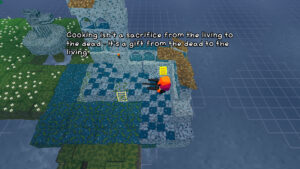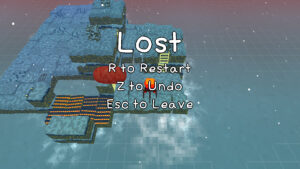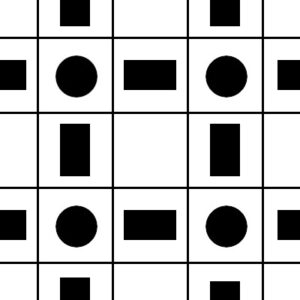Heavy spoiler for puzzle content continue here. This is one of those games that it’s impossible to talk about in any depth without spoiling puzzles. It’s a game of twists and turns, and the twists and turns take the form of breakthroughs in solving puzzles.
I’ve been describing the levels in SSR as being grouped into “worlds”, but in another sense, it’s all one world: one environment, with puzzles embedded in it. You can just walk all the way back to the beginning whenever you want. Individual puzzles, however, are self-contained. When you activate one, the rest of the world literally falls away, sinking into the water to temporarily isolate you. Two other changes happen at the same time: the grills light up, and certain immovable pink boxes with their own special shader turn into sausages. When you grill all the sausages, some unseen force eats them, removing the pink boxes from the overworld. There are also green boxes that turn into sausages when you complete all the puzzles in what I’ve been calling a “world”. The green box sausages are thus available in the overworld between the puzzles, and are used to reach the next world, typically by pushing them into a gap so you can walk across it.
That’s the pattern for the first five worlds, but the sixth breaks it in all kinds of ways. It all starts with a puzzle that appears to be absolutely impossible, because it gives you a sausage to grill and no grill to do it with. This puzzle is actually accessible from world 5, but can’t be solved until you you’ve solved all the world 5 puzzles and, by so doing, have a green box sausage that isn’t on bridge duty. That’s the first twist: that you can bring sausages into puzzles just by physically bringing them into the puzzle and leaving them lying on non-sinking ground. Suddenly the puzzles aren’t self-contained any more. The second twist is that you can keep stuff from sinking by wedging a sausage under it. It has to be a very specific sort of terrain feature: something with an overhead protrusion right next to the puzzle, so that a single sausage can lie half on the puzzle ground and half under the thing you want it to hold up. Up to this point, the sinking of the ground around the puzzle seemed like just a graphical flourish, but this twist establishes it as something physically real, and capable of physical interactions with puzzle elements.
And once your habits and assumptions have been so thoroughly upset, this immediately becomes the theme for all of the following puzzles. I had been thinking of the unlocking of green boxes as the thing that defines the boundaries between worlds, but now, every single puzzle unlocks one or more green boxes, giving you overworld sausages to use in the next puzzle.
Will there be more twists that alter the basic nature of the game in even bigger ways? Maybe not. Several things suggest that it’s all coming to a climax. For one thing, I’ve reached a point where the island curves back on itself, so that I can see the little wrecked boat where the game starts. That seems like an endgame thing. For another, there’s the plaques. Each world has an informational plaque or two in a prominent place, giving a little piece of the island’s history. In this gauntlet of green boxes, where every puzzle lets you go a little farther, there’s a plaque after every puzzle, giving you backstory at a much faster but still maddeningly slow rate. Right now, I’m at a point that seems like it’s just short of confirming all my worst suspicions, and it casts a lingering sense of dread over the whole game. It’s like A Monster’s Expedition crossed with Silent Hill 2.
 Comments(0)
Comments(0)

